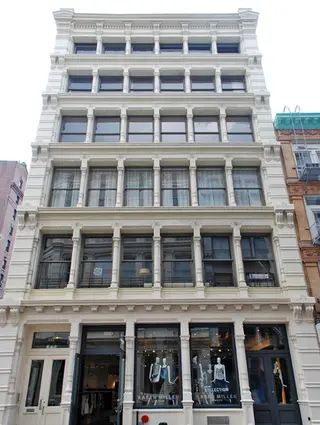 Carter Horsley
Carter HorsleyMar 16, 2015
Carter's Review
This very handsome and prominent SoHo cast-iron building at 112 Prince Street between Greene Street and West Broadway was designed in 1889 by Richard Berger for L. Sachs & Bro., importers and dealers in furs. Mr. Berger had designed a building for the Sachs brothers in 1885 at 26 West Houston Street and this building was completed in August, 1889.
The 6-story building has 5 apartments.
It is famous for the very large trompe l’oeil mural on its east façade that was created in 1975 by Richard Haas, the well-known photorealist painter.
Bottom Line
One of SoHo’s classic cast-iron buildings with only five apartments and a great Richard Estes mural on its east façade.
Description
The superb website, Daytonianinmanhattan.blogspot.com, said that Berger “had designed a clean ‘Neo-Grec’ façade not overly encumbered by ornamentation,” adding that “Slim, free-standing columns separated each set of windows at all six floors.”
“The architect,” the article continued, “treated each story identically, but slightly lessening the height of each succeeding floor; creating the illusion of a taller building. While undeniably utilitarian, the structure as light and airy with factory space awash in daylight. Crowning it all was a cast iron parapet with a sunburst motif.”
The Sachs concern sold the building just 8 months after its completion and commissioned Berger again for a new building at 27 West 4th Street. In 1913, James Thompson & Company leased the entire building for its manufacture of twine, mosquito netting, tartlatans and buckram.
In 1975, Richard Hass completed his large east façade mural that carried the Prince Street façade around the side of the building with a grant from the National Endowment of the Arts. He incorporated two real windows into the work’s large expanse, painted a protruding window air-conditioner and in one “open window” had two cats peering.
The first floor of the building is commercial space.
When Camper Shoes wanted to replace a one-story building on the corner just to the east of this building, public protests swamped the Landmarks Preservation Commission to protect the wonderful Haas mural and as a result only a one-story building was permitted. Unfortunately, the $100,000 needed to repair the façade in 2009 was not forthcoming and it has deteriorated as well as falling victim on its lower levels to graffiti.
Amenities
The building has a roof deck, a laundry room and private storage.
Apartments
The fifth floor unit has four bedrooms with 2,500 square feet of space and beamed ceilings of more than 11 feet and an Eco Smart fireplace. It has a 37-foot-wide living/dining area next to an open kitchen and a 9-foot-wide office.
The third floor unit is a two-bedroom residence with a 36-foot-wide living room with a 20-foot-long dining area and an 18-foot-long open kitchen with an island.
History
In 2014, Maya Lin, the artist who designed the Vietnam Veterans Memorial in Washington, D.C., when she was 21, sold her apartment in the building for $4.1 million and moved to 39 Bond Street.

- Co-op built in 1900
- 1 apartment currently for sale ($4.899M)
- Located in SoHo
- 5 total apartments 5 total apartments
- 8 recent sales ($1.1M to $6M)
 6sqft delivers the latest on real estate, architecture, and design, straight from New York City.
6sqft delivers the latest on real estate, architecture, and design, straight from New York City.
